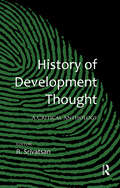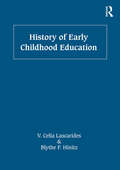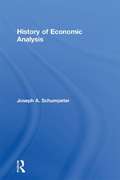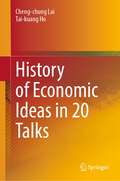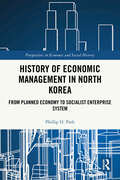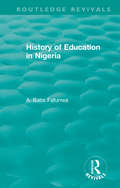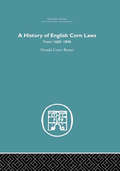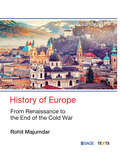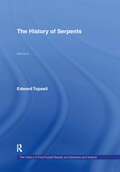- Table View
- List View
History of Cryptography and Cryptanalysis: Codes, Ciphers, and Their Algorithms (History of Computing)
by John F. DooleyThis textbook presents a fascinating review of cryptography and cryptanalysis, from the earliest known cryptographic systems of 2,500 years ago up to modern computer-based systems. The text relates the earliest use of the monoalphabetic cipher in the ancient world, the development of the “unbreakable” Vigenère cipher, and an account of how cryptology entered the arsenal of military intelligence during the American Revolutionary War. Moving on to the American Civil War, the book explains the solution of the Vigenère ciphers used by the Confederates and the use of telegraph codes, before investigating the development of cipher machines throughout World War I and II, including development of the first digital computer, Colossus. The exposition then explores cryptology in the computer age, from public-key cryptography and web security to criminal cyber-attacks and cyber-warfare. The role of cryptography in the Internet of Things is also discussed, along with the potential impact of quantum computing. Topics and features: Presents a history of cryptology from ancient Rome to the present day, with a focus on cryptology in the 20th and 21st centuries Provides engaging examples illustrating use of cryptographic algorithms in different historical periods Reviews algorithms and devices used to create secret messages, and the various methods for breaking such messages Describes notable contributions to cryptology by Herbert Yardley, William and Elizebeth Smith Friedman, Lester Hill, Agnes Meyer Driscoll, and Claude Shannon Examines unsolved mysteries in cryptology, such as the Voynich Manuscript, the Beale Ciphers, the Kryptos sculpture, and the Zodiac killer ciphers This engaging work is ideal as both a primary text for courses on the history of cryptology, and as a supplementary text for advanced undergraduate courses on cryptology and computer security. No prior background in mathematics is assumed, beyond what would be encountered in an introductory course on discrete mathematics.
History of Davis Islands: David P. Davis and the Story of a Landmark Tampa Neighborhood
by Rodney Kite-PowellTampa's Davis Islands has long been among the most desirable places to live on Florida's west coast. Created by David P. Davis during the 1920s Florida land boom, the project made him wildly rich and nationally famous. He followed up Davis Islands with a subdivision twice its size in St. Augustine, which he named Davis Shores. Davis sold his Tampa development in August 1926 but slipped into debt and died under mysterious circumstances while en route to Europe aboard a luxury liner in the early hours of October 13, 1926. Though he did not live to see it, work on Davis Islands continued, and the development ultimately became a huge success. Join author Rodney Kite-Powell as he examines the history of one of Florida's most famous neighborhoods.
History of Delaware County and Border Wars of New York (Excelsior Editions)
by Jay GouldWhen Jay Gould died in 1892 he left behind an estate worth the equivalent of seventy-eight billion in today's dollars. He also left behind a reputation as one of Wall Street's most shrewd, astute, and (some said) manipulative operators. Long before his adventures in finance, the future "robber baron" was a young man on the make in his native Catskills, working as a surveyor and mapmaker in his natal place of Delaware County, where he had grown up side by side with the future writer and naturalist John Burroughs. Originally published in 1856, when Gould was just twenty, Gould's History of Delaware County and Border Wars of New York is based on primary sources and original testimony from second and third generation settlers, many of them Gould's own friends and cousins. The book continues to be an important source on the first settlement of the region and is highly regarded by scholars. This edition features a new introduction by Edward Renehan, the biographer of both Gould and John Burroughs.
History of Development Thought: A Critical Anthology
by R. SrivatsanDevelopment thought emerged as the governing principle of First World global hegemony in the new world order marked by the end of the Second World War and decolonization. Six decades later, at yet another critical geopolitical conjuncture marked by globalization and neoliberal resurgence, History of Development Thought revisits the major strands in the development debate from the 1950s to the early twenty-first century. The volume places classic international interventions in critical development thinking alongside major contributions to the discourse from the Indian context.Beginning by juxtaposing W. A. Lewis’s classic liberal theory of the dual economy with P. C. Mahalanobis’s schema for planned development in India, the volume tracks the trajectory of the development debate — from the Latin American neo-Marxist paradigm, through the ‘mode of production’ debates in India, to Indian and international feminist perspectives on development. It explores the departures of the 1980s in India and elsewhere as theorists, including Pranab Bardhan, Sukhamoy Chakravarty, Partha Chatterjee, A. O. Hirschman, Samuel Huntington, and Amartya Sen, sought to address from various perspectives the reasons for the failure of development to live up to expectations. It ends with excerpts signposting the emerging strands of the development (and post-development) debate at the turn of the twenty-first century. Throughout, the volume remains committed to the paradigm of development as a horizon of critical thought and a field of democratic politics, while paying attention to the multiple storylines of the discourse over the last 60 years. This anthology, together with its critical introduction and rigorous prefatory remarks for each extract, will be invaluable to students and researchers in the social sciences and the humanities, especially those in development studies, history, politics and economics, as well as to activists, administrators, and professionals in health, education, and development.
History of Early Childhood Education: A History (Sourcebooks On Education Ser.)
by Blythe F. Hinitz V. Celia LascaridesHistory of Early Childhood Education presents a thorough and elegant description of the history of early childhood education in the United States. This book of original research is a concise compendium of historical literature, combining history with the prominent and influential theoretical background of the time. Covering historical threads that reach from ancient Greece and Rome to the early childhood education programs of today, this in-depth and well-written volume captures the deep tradition and the creative knowledge base of early care and education. History of Early Childhood Education is an essential resource for every early childhood education scholar, student, and educator.
History of Economic Analysis: With A New Introduction
by Joseph A. SchumpeterAt the time of his death in 1950, Joseph Schumpeter was working on his monumental History of Economic Analysis. Unprecedented in scope, the book was to provide a complete history of economic theory from Ancient Greece to the end of the second world war. A major contribution to the history of ideas as well as to economics, History of Economic Analysis rapidly gained a reputation as a unique and classic work. As well being an economist, Schumpeter was a gifted mathematician, historian, philosopher and psychologist and this is reflected in the multi-disciplinary nature of his great endeavour. Topics addressed include the techniques of economic analysis, contemporaneous developments in other sciences and the sociology of economics. This inclusiveness extends to the periods and individuals who figure in the book. As well as dealing with all of the major economists from Adam Smith to Maynard Keynes, the book considers the economic writings of Plato and Aristotle, of the Medieval Scholastics and of the major European economists. Throughout, Schumpeter perceived economics as a human science and this is reflected in a volume which is lucid and insightful throughout.
History of Economic Ideas in 20 Talks
by Cheng-chung Lai Tai-kuang HoThis book provides a concise history of economic thought for readers of all ages. While some basic economics knowledge would be helpful, it is not required. The book sets out to achieve three aims: to be interesting, entertaining, and thought-provoking. While the authors may appear opinionated in certain instances, this is intentionally done in order to alert readers to form their own views. History of ideas does not make the us smarter nor richer, but it can reduce our ignorance and the “banality of evil”—a term Hannah Arendt referred to people who lack self-reflection, “He did his duty...; he not only obeyed orders, he also obeyed the law.”
History of Economic Management in North Korea: From Planned Economy to Socialist Enterprise System (ISSN)
by Phillip H. ParkThis book seeks to understand how the economic construction of the Democratic People’s Republic of Korea (DPRK) evolved, shaped by the formulation and execution of various economic management systems spanning the years 1949 to 2023, in response to numerous challenges faced by the country.Split into four chapters, Park charts the developmental phases of the DPRK economy under Kim Il Sung, Kim Jong Il, and current leader Kim Jung Un. He carefully cross-examines sources from within the DPRK, including the Complete Works of Kim Il Sung, Selected Works of Kim Jong Il, the Rodong Shinmun, and the Chosun Central Yearbook. Where related literature relies on testimonies and interviews of defectors, this book offers a novel and comprehensive analysis of sources taken from North Korea, furnishing readers with new insights into the DPRK’s economic management and construction policies.With its novel approach, this book will be of interest to researchers and advanced undergraduates of Korean history, Korean studies, and economic history.
History of Education
by Patricia RosofHere are scholarly reviews of literature dealing with past and contemporary issues in public and private education, both nationally and cross culturally.
History of Education in Nigeria (Routledge Revivals)
by A. Babs FafunwaOriginally published in 1974, a comprehensive history of Nigerian Education, from early times right through to the time of publication, had long been needed by all concerned with Education in Nigeria, students, teachers and educational administrators. No one was better qualified than Professor Fafunwa to provide such a book, and in doing so he gave due emphasis to the beginnings of Education in its three main stages of indigenous, Muslim and Christian Education. Nigerian Education had been considered all too often as a comparatively recent phenomenon, but this book points out from the start that ‘Education is as old as Man himself in Africa’ and that both Islam and Christianity were comparative newcomers in the field. A historical treatment of these three strands which have combined to make up the modern Educational system was vital to a clear understanding of what was needed for the future, and most of the first half of the book is concerned with these Educational beginnings. The imposing of a foreign colonial system on this framework did not always lead to a happy fusion of the systems, and the successes and the failures are examined in detail. There was no shortage of documentary evidence in the form of reports and statistics during the decades prior to publication, but this evidence was frequently scattered and inaccessible to the student, so that the author’s careful selection of key evidence and reports, often drawn from his own personal experience, will be invaluable for those wishing to trace the development of Education in Nigeria up to the early 1970s. A knowledge of the history and development of the Nigerian Education system, of the numerous and intensely varied personalities and beliefs which have combined and often conflicted to shape it, is indispensable to all students in colleges and universities studying to become teachers. It is this knowledge that Professor Fafunwa set out to provide, drawing on his wide experience as teacher writer and educationalist.
History of England - IV: இங்கிலாந்து வரலாறு-IV
by Keith Feilingஇந்த புத்தகம் இங்கிலாந்தின் வரலாறு மற்றும் 1914-1918 முதல் உலகப் போர் ஆகியவற்றை உள்ளடக்கியது. போருக்குப் பின்னரான நிகழ்வுகளும் இந்நூலில் தெளிவாகக் குறிப்பிடப்பட்டுள்ளன.
History of English Corn Laws, A: From 1660-1846
by Donald Grove BarnesFirst Published in 2005. Routledge is an imprint of Taylor & Francis, an informa company.
History of English: A Resource Book for Students (Routledge English Language Introductions)
by Dan McIntyreRoutledge English Language Introductions cover core areas of language study and are one-stop resources for students. Assuming no prior knowledge, books in the series offer an accessible overview of the subject, with activities, study questions, sample analyses, commentaries and key readings – all in the same volume. The innovative and flexible ‘two-dimensional’ structure is built around four sections – introduction, development, exploration and extension – which offer self-contained stages for study. Each topic can also be read across these sections, enabling the reader to build gradually on the knowledge gained. This revised second edition of History of English includes: ❑ a comprehensive introduction to the history of English covering the origins of English, the change from Old to Middle English, and the influence of other languages on English; ❑ increased coverage of key issues, such as the standardisation of English; ❑ a wider range of activities, plus answers to exercises; ❑ new readings of well-known authors such as Manfred Krug, Colette Moore, Merja Stenroos and David Crystal; ❑ a timeline of important external events in the history of English. Structured to reflect the chronological development of the English language, History of English describes and explains the changes in the language over a span of 1,500 years, covering all aspects from phonology and grammar, to register and discourse. In doing so, it incorporates examples from a wide variety of texts and provides an interactive and structured textbook that will be essential reading for all students of English language and linguistics.
History of Europe in the Nineteenth Century (Collected Works)
by Benedetto CroceOne of Croce’s most famous books, originally published in 1934, this volume covers the history of Europe from the end of the Napoleonic Wars until the end of the First World War. Based on a series of lectures delivered in 1931 the book discusses, among other things, religious freedoms, the concept of liberty, liberalism and nationalism and the rise of the German state.
History of Europe: From Renaissance to the End of the Cold War
by Rohit MajumdarA concise textbook on the history of Europe viewed through the lens of economy, technology, information politics and war. History of Europe helps students, teachers and enthusiasts of history to gain an understanding of the genesis of modern Europe. The book has been structured in an unconventional yet logical manner, keeping in mind the difficulty students face while relating facts and time periods in history. It is segregated into four modules, which bring in multiple angles to provide an all-encompassing perspective of European history along with a parallel understanding of world history, thus establishing a holistic framework of the events. The modules cover Renaissance to pre-Napoleonic era, holocausts to consolidation of global sustainability, Cold War era, and the conflict and culture in European globalization since 1989. Thorough integration maps, illustrations and special vignettes make the textbook interactive, informative and illustrative for students to easily internalize and recollect the major events and their causes and consequences. Key Features: • A unique learning experience of history through extensive chronological detailing and multiple parallels of events • Includes forty-one maps, which act as visual guides to the geography of politics, campaigns, battles and expansion of empires • Commentary sections summarizing the key themes and examining global and comparative developments going beyond the geographic framework • First-hand notes and commentaries of the First and Second World Wars and eyewitness accounts • Extensive source citations along with weblinks and suggestions for further reading
History of Finance Capital in America: The Great Depression and Interwar Years (ISSN)
by Go Tian KangGo details through institutional analysis how major financial institutions (including banks and insurance companies), industries, and the U.S. government behaved and linked with each other during the Great Depression and interwar period.Drawing on data that has not been widely used since the late thirties – including congressional hearings, financial data, and government reports concerning economic concentration in the Depression era – Go presents a general picture of American finance capital on the eve of World War II. He details the emergence of important new financial‑industrial powers in the 1920s that challenged the Wall Street’s established order on the eve of Great Depression, the response of the Wall Street’s finance capital to the challenge, and its renewed dominance as well as the growing community of interests between finance and industry under the Depression. He also points out the role of Wall Street’s finance capital in financing the Reconstruction Finance Corporation in 1932, the New Deal, and the emerging war economy.With its coverage of primary sources, this book will interest researchers and advanced undergraduate students taking American history, political science, and institutional economics.
History of Four Footed Beasts and Serpents and Insects: Volume 2 Serpents
by Edward TopsellFirst Published in 1967. This is volume two of three of The History of Four- footed Beasts taken principally from the ‘ Historite Animalium’ of Conrad Gesner. During the first decade of the seventeenth century, when Topsell prepared his translation, zoology had just become a science. It has a unique place: It was the first major book on animals printed in Great Britain in English; and it appeared at the last moment in history when all zoological knowledge since antiquity could be summarized sympathetically, before it was rendered a curiosity by the many new discoveries soon to come.
History of Four Footed Beasts and Serpents and Insects: Volume 3 Insects
by T. MuffetFirst Published in 1967. This is final volume in a set of three of The History of Four- footed Beasts taken principally from the ‘ Historite Animalium’ of Conrad Gesner. During the first decade of the seventeenth century, when Topsell prepared his translation, zoology had just become a science. It has a unique place: It was the first major book on animals printed in Great Britain in English; and it appeared at the last moment in history when all zoological knowledge since antiquity could be summarized sympathetically, before it was rendered a curiosity by the many new discoveries soon to come.



